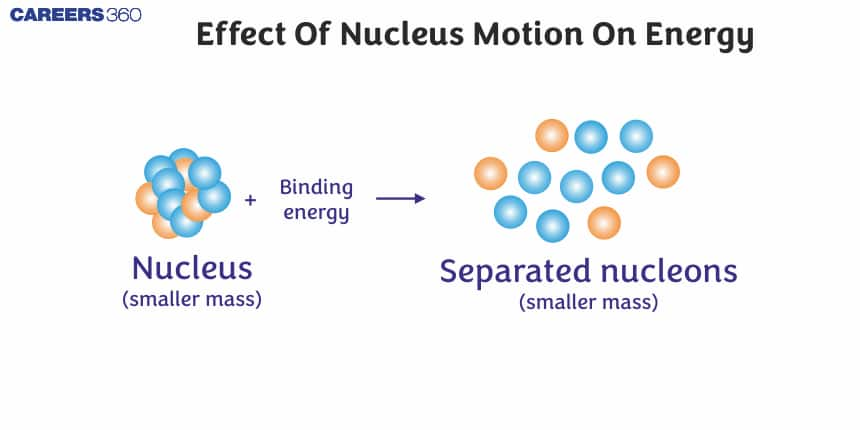Effect Of Nucleus Motion On Energy
The effect of nucleus motion on the energy of Bohr's second postulate is a significant aspect of understanding atomic structure. Bohr's second postulate describes the quantized nature of electron orbits around a nucleus, where electrons can only occupy specific energy levels. When considering the motion of the nucleus, the energy levels shift slightly, refining the accuracy of atomic models. This nuanced understanding is crucial in fields like spectroscopy and quantum mechanics, impacting technologies such as atomic clocks and MRI machines, where precise measurements of atomic behaviour are essential for accurate results. This article explores how nucleus motion influences energy levels and the broader implications in scientific and practical applications. In this article, we will discuss the concept of the Effect of Nucleus Motion on Energy and provide examples for concept clarity.
This Story also Contains
- Effect of Nucleus Motion on Energy
- Solved Examples Based on the Effect of Nucleus Motion on Energy
- Summary

Effect of Nucleus Motion on Energy
Till now in Bohr's model, we have assumed that all the mass of the atom is situated at the center of the atom. As the mass of the electron is very small and negligible as compared to the mass of the nucleus all the mass is assumed to be concentrated at the centre of the nucleus. But actually, the centre of mass of the nucleus-electron system is close to the nucleus as it is heavy, and to keep the centre of mass at rest, both electrons and the nucleus revolve around their centre of mass like a double star system as shown in the figure. If r is the distance of the electron from the nucleus, the distances of the nucleus and electron from the centre of mass, $r_{1}$ and $r_{2}$, can be given as
and

We can see that the atom, nucleus, and electron revolve around their centre of mass in concentric circles of radii
Now we can change our assumption and the system will look like as shown in the figure with reduced mass

Now we can derive the equation obtained by Bohr with the reduced mass also
Now after replacing the electron mass with its reduced mass, the equation becomes
But there will be no effect on the velocity because the term of mass is not present there -
Similarly for energy, we can write that
After putting the reduced mass in the equation
Thus, we can say that the energy of electrons will be slightly less compared to what we have derived earlier. But for numerical
calculations this small change can be neglected unless in a given problem it is asked to consider the effect of the motion of the nucleus.
Recommended Topic Video
Solved Examples Based on the Effect of Nucleus Motion on Energy
Example 1: A positronium atom is a system that consists of a positron and an electron that orbit each other. The ratio of wavelength of the spectral line of positronium to that of ordinary hydrogen is:
1) 2:1
2) 4:1
3) 1:2
4) 1:4
Solution:
Effect of nucleus motion on the energy of the atom
wherein
since the two-particle has the same mass
since
Hence energy level of the positronium atom is half of the corresponding energy level in the H-atom.
As a result, the wavelength in the positronium atom spectral lines is twice those of corresponding lines in the hydrogen spectrum.
Hence, the answer is the option (3).
Example 2: The wavelengths involved in the spectrum of deuterium
1) The sizes of the two nuclei are different
2) nuclear forces are different in the two cases
3) masses of the two nuclei are different
4) The attraction between the electron and the nucleus is different in the two cases.
Solution
The wavelength of spectrum is given by
Masses of
Hence, the answer is the option (3).
Example 3: A muon is an unstable elementary particle whose mass is
1)
2)
3)
4)
Solution:
Here
According to equation
Hence, the radius
Hence, the answer is the option (3).
Example 4: A nucleus of mass
1)
2) 0
3)
4)
Solution:
When the nucleus emits $\gamma$- ray there will be recoiling of the nucleus.

By momentum conservation,
Here negative sign implies the opposite direction motion of the nucleus (recoiling) when $\gamma$-ray emission takes place.
Internal energy lost by the nucleus is given to the nucleus and x-ray.
Hence, the correct option is (4).
Example 5: A diatomic molecule is made of two masses
1)
2)
3)
4)
Solution:
A diatomic molecule consists of two atoms of masses $m_{1}$ and $m_{2}$ at a distance $r$ apart. Let $r_{1}$and $r_{2}$ be the distances of the atoms from the centre of mass
The moment of inertia of this molecule about an axis passing through its centre of mass and perpendicular to a line joining the atoms is
The solution is correct. So no need to change it
On rearranging, we get
similarly
Therefore, the moment of inertia can be written as
According to Bohr’s quantisation condition
or
Rotational energy,
Summary
The effect of nucleus motion on the energy of Bohr's second postulate refines our understanding of atomic structures by considering the slight shifts in energy levels due to the nucleus's movement. This adjustment is crucial for precision in fields like spectroscopy and quantum mechanics, affecting technologies such as atomic clocks and MRI machines. The solved examples illustrate how this consideration impacts the spectral lines of positronium, deuterium, muonic atoms, and the internal energy of nuclei, highlighting the practical implications of incorporating nucleus motion in atomic models.
